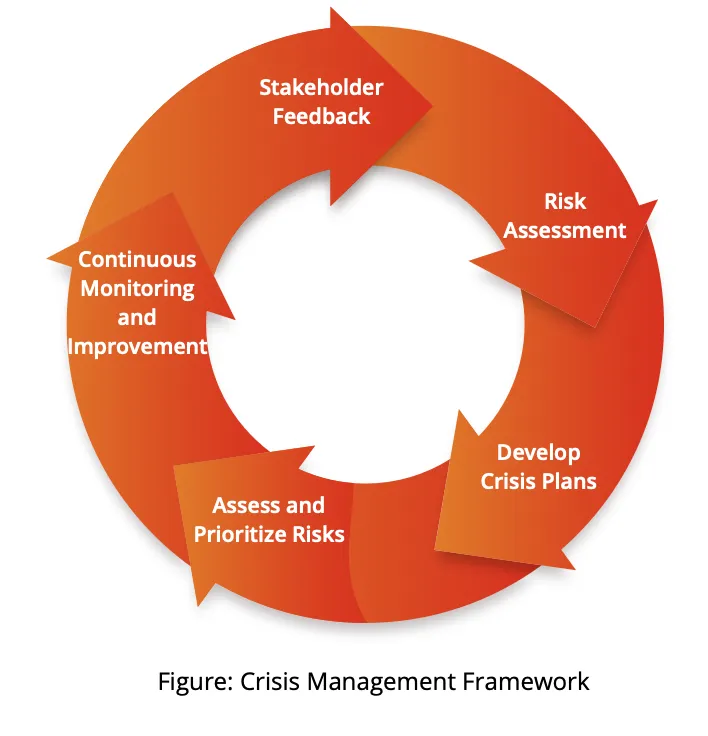
From Crisis to Stability: Strategies for Building Organisational Resilience and Growth
In recent years, the landscape of business crises has transformed dramatically, not only growing in variety but also in the frequency and intensity of their impact on businesses. This shift has been propelled by rapid technological advancements the pervasive influence of social media, and intensified stakeholder activism which have transformed crisis management into a dynamic, ever-evolving field. Companies now face a broad spectrum of challenges, from cyber threats to financial instability, each demanding swift and effective responses. The changing nature of these threats means that companies must not only be prepared but also remain agile in adapting to new challenges as they arise.
Traditional reactive approaches to crisis management are no longer adequate. Instead, the focus has shifted towards resilience—a proactive framework encompassing anticipation, preparation, response, and recovery. In today's volatile business environment, proactive crisis management is not merely advantageous; it is indispensable. By embracing resilience, companies emerge stronger, leveraging challenges as opportunities for growth and innovation. Preparedness and clear management strategies are fundamental pillars of success, guiding businesses through uncertainty with confidence and positioning them as industry leaders.
Pillars of Effective Crisis Management
- Integrity in communication: Align actions with company objectives.
- Transparency: Build trust through honesty.
- Accountability: Ensure stakeholders own their roles.
- Adaptability: Adjust strategies as situations evolve.
- Human-centric approach: Recognise and address the human impact of crises.
- Stakeholder engagement: Seek inclusive responses through proactive collaboration.
To further enhance our understanding of how well these pillars are being implemented and areas that require more focus, consider these key statistics from a survey:

With these pillars in place, the next step is developing a robust crisis management strategy. This should be proactive and detailed, encompassing both pre-crisis preparations and dynamic during-crisis actions to suit the needs of the company.
Developing an Effective Crisis Management Strategy
In today's business environment, characterized by rapid changes and unexpected challenges, a crisis management strategy is more than a necessity—it's a cornerstone of sustainable success.
We have endeavoured to present comprehensive categories filled with actionable steps to provide tangible benefits for founders.

Pre-crisis Actions
1. Risk assessment and preparation
- Evaluate potential financial risks such as market volatility, liquidity crunches, and debt overhangs.
- Technological risks like cybersecurity threats and data breaches, as well as environmental factors like natural disasters or regulatory changes, must also be evaluated.
- Engage with stakeholders through surveys and social media monitoring to gauge perceptions and spot emerging issues early.
- Scenario planning is crucial - work across teams to simulate various crisis scenarios to predict outcomes and identify potential early warning signs.
2. Develop and review crisis plans
- Set up a dedicated crisis management team composed of members selected for their expertise and decision-making capabilities under pressure.
- Define the roles and responsibilities within the crisis management team, ensuring that alternative decision-makers are identified in case primary leaders are unavailable.
- Develop response procedures and playbooks for quick action and coordinate these efforts with all relevant internal and external stakeholders.
- Regularly update and test these crisis plans through drills and simulations, making sure all team members are familiar with their duties during a crisis.
- Provide guidelines for escalating issues and thresholds, when necessary.
During-crisis Actions
1. Activate crisis management protocols
- Implement the pre-defined procedures to guide the initial response.
- Ensure that the actions adhere to the established escalation and decision-making frameworks to enable effective management.
2. Establish clear lines of communication
- Maintain open and transparent channels to disseminate crucial information swiftly and efficiently to all stakeholders, while maintaining confidentiality and carefully managing the tone of the messaging.
- Appoint a lead crisis manager to oversee communications and decision-making processes.
3. Assess and prioritise risks
- Continuously evaluate the evolving risks, prioritizing them based on their potential impact.
- Allocate resources effectively to address the most critical issues first.
- Always consider legal and regulatory frameworks in your decision-making process. Consulting with legal advisors to ensure compliance is crucial to mitigate potential legal risks.
4. Engage key stakeholders
- Work closely with internal and external stakeholders, including employees, customers, suppliers, and regulators.
- Through decisive leadership and open communication, reassure stakeholders of your organization's competence in managing the situation, thereby maintaining their trust and confidence.
Post-crisis actions |3R’s for Restoring Business Operations
Review: After managing a crisis, conduct a thorough review to identify what worked and what didn’t. Reflect on these insights to improve future crisis response strategies.
Recovery: Focus on recovery efforts to stabilise operations and address any residual effects of the crisis. Adjust business processes as necessary to adapt to new realities and enhance resilience.
Re-evaluate: Evaluate and enhance your governance structures to bolster crisis management capabilities. Implementing these improvements will ensure better preparedness and response for future crises.
Board-driven Crisis Management Strategy
Founders should actively seek the support of investors and board, utilizing their extensive experience in crisis management to procure valuable insights. This collaborative approach can enhance the strategic capabilities of the board, ensuring more robust and informed decision-making during critical times.
- Assess whether the crisis management plan developed by the founders and management team is appropriate for the company's needs.
- Facilitate active participation in crisis simulations for key board members.
- Establish and maintain a designated board committee to oversee annual crisis exercises.
- Develop and review a comprehensive crisis communication and disclosure plan periodically.
- Regularly evaluate the interrelationships and impacts of various risks through detailed assessments.
- Periodically review and define the board's risk thresholds and comfort levels.
- Ensure adequate board representation in crisis communication planning and execution.
- Schedule regular audits or engage external validators to assess the crisis management system’s effectiveness.
- Identify and periodically re-assess the roles and responsibilities of key advisors and professionals to support the company in crisis.
- Systematically incorporate stakeholder feedback into crisis management practices.
Conclusion
Warren Buffett wisely noted, "It takes 20 years to build a reputation and five minutes to ruin it. If you think about that, you’ll do things differently."
This underscores the critical importance of crisis management as a fundamental component of a company's strategy for growth and survival. In today's dynamic business environment, the significance of being thoroughly prepared for potential crises cannot be understated. Preparedness is not just a defensive measure; it is a strategic advantage that ensures business continuity and safeguards reputation.
The journey from crisis to stability is deliberate and structured, requiring meticulous planning, dynamic leadership, and constant enhancement. The board's role in navigating an organization through crises is pivotal. Boards must ensure that crisis management strategies are robust, proactive, and aligned with the organization's core values and objectives. By fostering a culture of readiness, transparency, and adaptability, boards enable their teams to transform potential threats into opportunities, ultimately steering the company toward growth and innovation. In this way, organizations can not only survive but thrive, turning challenges into catalysts for strengthening their future.
DISCLAIMER
The views expressed herein are those of the author as of the publication date and are subject to change without notice. Neither the author nor any of the entities under the 3one4 Capital Group have any obligation to update the content. This publications are for informational and educational purposes only and should not be construed as providing any advisory service (including financial, regulatory, or legal). It does not constitute an offer to sell or a solicitation to buy any securities or related financial instruments in any jurisdiction. Readers should perform their own due diligence and consult with relevant advisors before taking any decisions. Any reliance on the information herein is at the reader's own risk, and 3one4 Capital Group assumes no liability for any such reliance.Certain information is based on third-party sources believed to be reliable, but neither the author nor 3one4 Capital Group guarantees its accuracy, recency or completeness. There has been no independent verification of such information or the assumptions on which such information is based, unless expressly mentioned otherwise. References to specific companies, securities, or investment strategies are not endorsements. Unauthorized reproduction, distribution, or use of this document, in whole or in part, is prohibited without prior written consent from the author and/or the 3one4 Capital Group.




.png)









